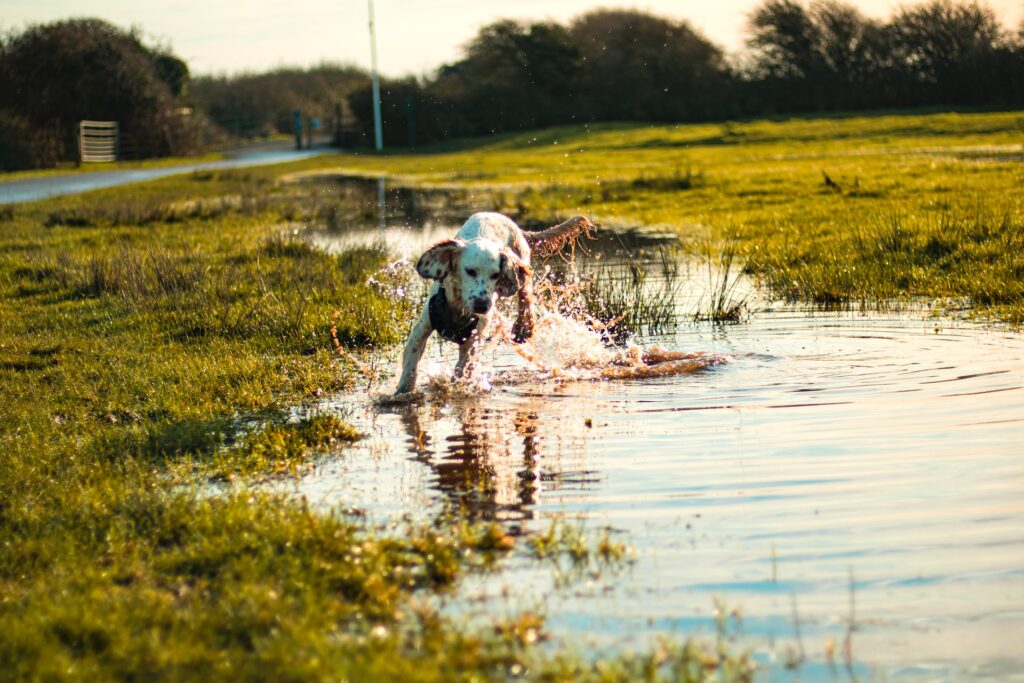Whenever we think we know our dogs well, they seem to surprise us. There are a lot of videos online with dogs walking in reverse which seems improbable. So can dogs walk backwards, or are the videos fake?
Dogs have the ability to walk backward, although it’s not as natural as forward movement. They may do so for playful or cautious reasons. The mechanics behind this intriguing behavior continue to fascinate researchers.
- How does canine locomotion work?
- Why do dogs walk backwards? Unveiling the natural instincts
- What are some serious issues that may cause this behavior?
- How can you teach a dog to walk backward through training?
- Do other animals walk backward?
How does canine locomotion work?
Canine limbs are designed for powerful forward propulsion, optimized for chasing, running, and navigating their environment. They have a flexible spine and good core muscles making it easier to stretch. The lower bones of their front legs are separate and allow rotation, while the feet can easily grip the ground.
In forward movement, a dog’s muscles and joints work in harmony to create efficient strides. First, they put their left hind leg forward followed by the left foreleg. Then, the right hind leg continues, followed by the right foreleg.
Nevertheless, the act of walking in reverse demands a distinct coordination of muscles and joints, resulting in a seamless reversal of movement.
Why do dogs walk backwards? Unveiling the natural instincts
Dogs are inherently curious creatures, often exploring their surroundings with unwavering enthusiasm. This can lead them to take a step backward, especially when they encounter something unfamiliar that catches their attention. Their backward movement might be an instinctual response to new scents or sounds that were presented..
This interesting behavior can also be recognized when the dog wants to play with its owner. You might have also noticed that your dog will jump on you as a sign of affection. Dogs will start walking backwards as a way to communicate with the owner or seek attention. It’s their way of saying, “Look at me! I’m here, and I’m excited!“
This behavior is analogous to a dog’s way of signaling their presence and intent. It’s not merely a random movement, but it’s a deliberate action to convey their emotions and desires.
What are some serious issues that may cause this behavior?
Even though the reasons why dogs walk backwards might be completely natural, there are a few cases where you should consider seeking help.
Hip discomfort and pain
If a dog experiences discomfort or pain in their hip joints, they might naturally adopt a walking style that alleviates pressure on those joints. This could lead to using their rear-end to open doors, while walking in reverse.
Hip dysplasia is a common health problem in most dogs. It happens when the ball and socket hip joint is misaligned. This can happen while the dog is young, and if not treated can lead to developing arthritis. Having a loose patella can also be a reason for reverse walking in dogs.
Past trauma and its influence on behavior
Dogs that have experienced past accidents or traumatic incidents might develop behavioral responses as a coping mechanism. Walking backward could be a result of their attempt to cautiously navigate their environment or even a subconscious way of protecting themselves.
By doing this, the dog tries to look bigger in order to scare off the threat. Also, it allows it to keep the eye on the perceived target so to not feel vulnerable. Dogs might also show this behavior during thunderstorms or fireworks as they can cause fear and anxiety.
Cognitive Dysfunction Syndrome
This disease is akin to dementia in dogs and can lead to unusual behaviors. “Dogs may start to develop CDS around nine years of age, or older. The condition may be underdiagnosed since the behavioral changes progress slowly, and owners may assume that some changes are a normal part of aging.”, according to the Cornell University College of Veterinary Medicine.
It’s plausible that dogs walking in reverse might have cognitive decline. This disease can affect a dog’s cognitive functions, leading to confusion and altered movement patterns. Dogs with this disease will often seem dissoriented and lose their memory. These dogs will also leave odorless wet spots around the house due to incontinence.
Sensory problems
Neurological disorders, such as vestibular disease, can affect a dog’s balance and coordination, causing it to walk in reverse. The vestibular system is responsible for maintaining balance. This system can be damaged due to ear infections, tumors, or trauma to the skull. According to Davies Veterinary Specialists, the symptoms of this disease also include:
| Neurological disorders, such as vestibular disease, can affect a dog’s balance and coordination, leading to irregular movements like walking backward. Eye problems like cataracts or retinal atrophy might also impact a dog’s ability to navigate their environment correctly. |
Eye problems like cataracts or retinal atrophy might also impact a dog’s ability to navigate its environment correctly.
How can you teach a dog to walk backward through training?
If you find backward walking dogs amusing and think it’s something you want to teach your dog as a trick, you can. The best technique to use in this situation is positive reinforcement. This is when you use a reward like treats and praise to give your dog whenever it does what you ask of it. By associating rewards with backward steps, you can encourage your dog to perform this behavior on command.
What is the training procedure?
To do this, stand opposite your dog in a narrow hallway. Then, take a step toward your dog. If it moves a step back, give it a treat. Continue until it starts associating the movement with treats. Then, use the command “retreat” whenever you start doing the exercise. Now, the word is also associated with the behavior. With time, you should stop moving and just let the dog move with the command only. After some time, it will listen to you even without having a treat.
Patience and consistency are key here, as every dog learns at a different pace. For example, Bulldogs are very stubborn and require a bit more time than other dogs to learn something. If you need help with training dogs to walk in reverse, you can hire a professional dog trainer for help. Certified animal behaviorists can offer invaluable guidance in modifying a dog’s behavior effectively. Their expertise can ensure that the training process is stress-free for both you and your furry companion.
Do other animals walk backward?
Dogs are not the only animal that possesses the remarkable ability to exhibit backward walking. Some primates, birds, and insects also display retrograde motion. However, each species has distinct traits and reasons for its backward movement.
However, there are certain animals that are unable to walk backward. The kangaroo and emu, both Australian animals, do not possess this interesting behavior.

A conclusion – Can dogs walk backwards?
Dogs are intrinsicly designed to move forward. But they do have the capabilities to perform backward movement if needed. Even if sometimes it may seem like an odd behavior to their owners.
You can see a dog walking against the norm because it might be feeling curious or playful. The dog might realise that it’s the only way to get your attention. Sometimes, a more serious issue may be causing this issue. Dogs may feel scared or traumatised from something and exhibit this behavior. They might also suffer from a sensory or cognitive disease.
The most important thing you can do as the owner is to notice any signs on time and converse with a vet on the following steps. Most of the time this behavior will be harmless.
FAQ
Why do dogs like to walk ahead?
Some dogs like to lead and be in control of the situation, hence why they might walk in front of their owners. Others will feel it’s the best way to protect their owner. And then some are just curious and full of energy.
Can dogs hurt themselves by walking backward too often?
While occasional backward walking is usually harmless, excessive or repetitive backward movement might strain a dog’s muscles and joints. It’s best to monitor your dog’s behavior and consult a veterinarian if you have concerns.
Can dogs walk sideways or only forward?
Dogs can walk backwards and forwards, but some can even go sideways. Dogs with short body length and long legs are usually more prone to this behavior. This includes breeds like German Shepherds and Border Collies.
What role does a dog’s tail play in its balance and movement?
The tail helps the dog maintain its balance by putting some weight on the opposite side of the dog’s head. It is also very useful when dogs run and helps them change direction easily and smoothly.
More dog behavior resources
Here are a few other resources talking about other unusual behavior in dogs and how to deal with them.
- Do dogs get tired of barking
- Why does my dog jump on me
- Why does my dog lay on me
- Signs that a male dog wants to mate
- Dog won’t eat in the morning
You can find a lot more information on weird dog behaviors on our site Dogisa!
My Dog Won’t Eat His Food But Will Eat Human Food: Useful Tips
Are you a concerned dog owner questioning “why my dog won’t eat his food but…
Uncovering the Mystery: Why Do Dogs Roll in the Dirt?
Picture this: you’re out for a leisurely stroll with your furry friend when suddenly, they…
Why Do Dogs Chew On Wood? How To Make Them Stop
Dogs are avid chewers. They can chew on all kinds of materials. Even materials that…
Dog Holding Its Mouth Slightly Open – What Is The Reason?
Dogs can do all kinds of weird behaviors that surprise and worry us. But what…
Dog Suddenly Sleeping in a Different Room – What You Can Do
We often want to cuddle up with our pups during the evening and end up…
Can Dogs Walk Backwards? A Strange But Remarkable Skill
Whenever we think we know our dogs well, they seem to surprise us. There are…







